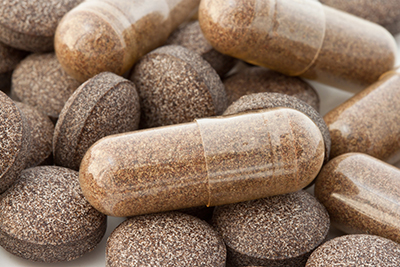Has SAD Got You Down?
What is it and what causes it? Seasonal affective disorder (SAD) is a form of depression that occurs during certain times of the year. It generally occurs during the colder months and is associated with shorter days. Reduced sunlight exposure during the fall and winter can disrupt the body’s internal clock, also known as the circadian rhythm. The circadian rhythm has many roles: It influences the sleep-wake cycle, hormone release, and body temperature.[1] The circadian rhythm responds to cues in your surroundings, especially light and dark. A hormone called melatonin is produced from the pineal gland in the brain at night in order to help you sleep. Shortened daylight hours can alter this natural rhythm and lead to SAD.[2]
Low serum vitamin D levels have been associated with a higher likelihood of SAD.[3] The solar ultraviolet-B (UVB) rays are not strong enough during the winter months from November to March, and therefore our bodies are not able to produce vitamin D; vitamin D production occurs within the epidermis of the skin when exposed to UVB sunlight. Meanwhile, numerous variables affect skin synthesis of vitamin D, including latitude, season, time of day, degree of skin pigmentation, and sunscreen use.[4]
Who Does It Affect?
Two to three percent of Canadians will experience SAD in their lifetime. Another 15% will experience a milder form of SAD (known as the “winter blues”) that leaves them only slightly depressed, but still able to function without any major disruptions. People with SAD make up about 10% of all depression cases.
SAD is also thought to run in families, as 13–17% of people who develop SAD have an immediate family member with the disorder.[5]
Adults seem to be at higher risk of developing SAD compared to teenagers and children; meanwhile, women are more likely to experience SAD than men. Researchers are not sure why the latter is so, but it may be because of increasing life responsibilities, and therefore stress levels, that adults and women suffer more. People in northern countries and cities are more likely to experience SAD than those who live close to the equator. The amount of daylight you receive changes as you move north, and that change is thought to be a part of SAD.[5]
Signs and Symptoms
The symptoms of SAD vary from one individual to the next, but the spectrum includes irritability, overeating and associated weight gain, sadness, depression, fatigue, feelings of guilt and worthlessness, difficulty concentrating, body aches, changes in sleep patterns, a loss of interest for life, and decreased sex drive.[5]
 There is no cure for SAD; however, treatments do exist that can help you feel your best during the cold winter months. It is important to speak with your naturopathic doctor to determine whether your symptoms are due to SAD or another condition. There are many reasons why individuals may feel down or have low energy, and your naturopathic doctor can help determine what the underlying cause may be.
There is no cure for SAD; however, treatments do exist that can help you feel your best during the cold winter months. It is important to speak with your naturopathic doctor to determine whether your symptoms are due to SAD or another condition. There are many reasons why individuals may feel down or have low energy, and your naturopathic doctor can help determine what the underlying cause may be.
Lifestyle Recommendations
 Exercise: Bodies are meant to move. Endorphins are produced when we exercise, and these endorphins help us feel good overall. Exercise has many other health benefits, including weight loss, improved sleep quality, and greater focus and concentration. Morning exercise may be beneficial in the treatment of SAD.
Exercise: Bodies are meant to move. Endorphins are produced when we exercise, and these endorphins help us feel good overall. Exercise has many other health benefits, including weight loss, improved sleep quality, and greater focus and concentration. Morning exercise may be beneficial in the treatment of SAD.
Attend Group Outings and Social Events: Talking with friends and family can help lift moods. A support system is important for optimal mental health and wellbeing. Being around people with similar interests can help motivate you to engage in activities that are pleasurable.
Meditation: Meditation is an effective technique to relax and switch the nervous system from a sympathetic (“fight-or-flight”) mode to a parasympathetic (“rest-and-digest”) state. Guided meditations are great for stress reduction, anxiety, and depression. Some meditations utilize deep-breathing and body-scan techniques to increase awareness and focus/concentrate on specific body parts that may require attention.
Colour: Adult colouring books are in—and so are mandalas! Mandalas are circular shapes that are used as tools to facilitate meditation. These shapes are repetitive and allow one to experience a similar sense of relaxation, along with all the other health benefits, that come from meditating.
Natural Treatments
Vitamin D: During the appropriate season, exposing arms and legs to the sunlight for 5–30 minutes twice weekly may be sufficient to meet vitamin D requirements.[4] Vitamin D is important for optimal immune-system functioning, bone development, and mental health/wellbeing. Vitamin D is poorly absorbed from the diet, and the majority of Canadians are deficient in the winter months. Naturopathic doctors can check your vitamin D status by means of a simple blood test, and prescribe an appropriate dose according to serum levels.
Light Therapy: Missing daylight hours can be replaced with an artificial substitute to help reduce symptoms of SAD. Patients sit in front of a light-box or wear a visor according to a doctor’s recommendation. The box shines light much brighter than ordinary indoor lighting. Studies show light therapy relieves SAD symptoms for as much as 70% of patients after a few weeks of treatment, and some note improvements before then.
Omega-3 Essential Fatty Acids: Healthy fats are important for nerve and brain function. The eicosapentaenoic acid (EPA) component is responsible for the antidepressant effects of supplemental omega-3. EPA is known to reduce depression, as it is critical for the dynamic structure and function of neuronal membranes. It is also required for neurotransmitter binding and signaling within the cell. Dose varies from 1 to 4 g/d with food.[6]
 B-Complex: Studies show that B-complex vitamins resulted in significantly lower personal strain and depressive moods. Improved ratings of stress and mental health were also noted. Take one B-50 or B-100 complex capsule per day with food.[6]
B-Complex: Studies show that B-complex vitamins resulted in significantly lower personal strain and depressive moods. Improved ratings of stress and mental health were also noted. Take one B-50 or B-100 complex capsule per day with food.[6]
5-HTP: This precursor is important for serotonin production. Serotonin is involved in mood and appetite regulation, and it also has antianxiety effects. Serotonin is also important for melatonin synthesis.[6]
Melatonin: Melatonin helps regulate our internal clock, which can be offset during the winter months. Exogenous sources can be taken temporarily to help regulate the circadian rhythm. Dosing ranges vary depending on the condition being treated; speak to your naturopathic doctor to determine which dose is best suited to your needs.[6]
Conclusion
SAD is a form of depression that can be debilitating; it results from decreased sunlight exposure and an altered circadian rhythm. Other mental health disorders can have similar symptoms to those of SAD. Although research suggests there is no “cure” for SAD, there are various lifestyle recommendations and natural treatments available to help diminish symptoms. Speak with your naturopathic doctor before commencing a new supplement regimen, in order to determine which treatment method might be best suited to your particular needs. Supplements may have their own set of side effects, and your naturopathic doctor will discuss dose and any potential side effects to be aware of, if necessary. Natural products can interact with other medications, so it is important to let your naturopathic doctor know what you are currently taking.
References
1. National Institute of General Medical Sciences. Circadian Rhythm Fact Sheet · https://www.nigms.nih.gov/Education/Pages/Factsheet_ CircadianRhythms.aspx · Reviewed 2016-03-14.
2. NIH News In Health. Beat the Winter Blues: Shedding Light on Seasonal Sadness · https://newsinhealth.nih.gov/issue/Jan2013/Feature1 · January 2013.
3. Gloth, F.M., W. Alam, and B. Hollis. “Vitamin D vs broad spectrum phototherapy in the treatment of seasonal affective disorder.” Journal of Nutritional Health and Aging, Vol. 3, No. 1 (1999): 5–7.
4. Oregon State University. Linus Pauling Institute Micronutrient Information Center. (V.J. Drake, reviewed by D.D. Bikle). Vitamin D and Skin Health · http://lpi.oregonstate.edu/mic/micronutrients-health/skin-health/nutrient-index/vitamin-D · November 2011.
5. Canadian Mental Health Association—British Columbia Division. Get Informed: Seasonal Affective Disorder · https://www.cmha.bc.ca/get- informed/mental-health-information/sad · 2012.
6. Prousky, J. Textbook of Integrative Clinical Nutrition. Toronto: CCNM Press Inc., 2012, 506 pages (here p. 397–398 and 402–403).
 Dr. Ashley Kowalski, HBSc, ND
Dr. Ashley Kowalski, HBSc, ND
Ashley is a licensed naturopathic doctor practicing in Ontario. Some of her main focus of interests are digestive complaints/food sensitivities, women’s health, and thyroid issues.
ashleykowalskind.com

 Stores
Stores